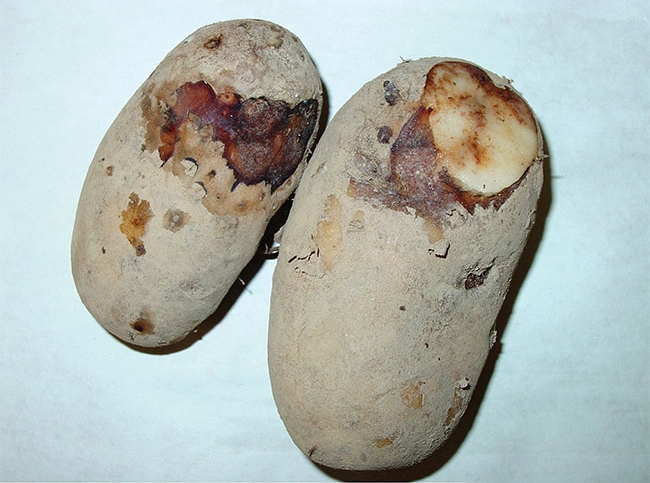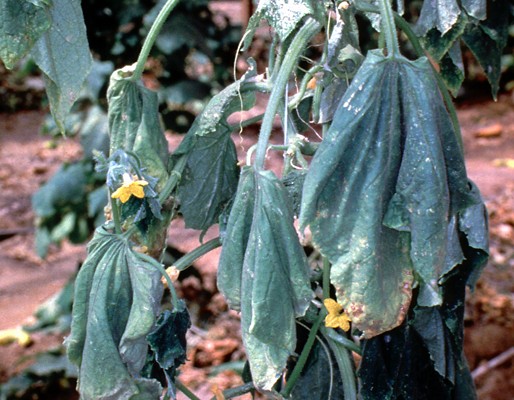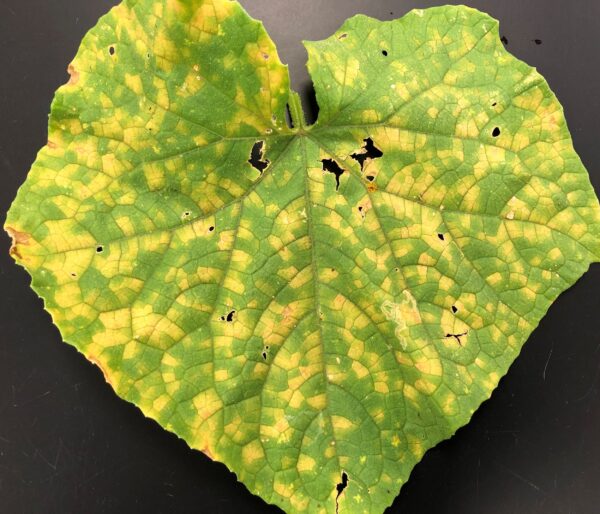Every farmer, regardless of their experience or the type of crops they cultivate, will inevitably face the challenge of plant diseases on their farms. These diseases can be a constant threat, capable of wreaking havoc on crops and causing significant economic losses.
However, by becoming familiar with these diseases, farmers can identify them early and develop effective strategies to combat them head-on.
In this article, we will explore five common diseases that pose a serious threat to farms, and discuss their symptoms and proven strategies to mitigate their impact. So, let’s check out some of those diseases you should look out for and how best you can combat them.
1. Late Blight
Late blight is a highly destructive plant disease caused by the fungal pathogen Phytophthora infestans. It poses a significant threat to various crops, including tomatoes and potatoes.

Symptoms
The symptoms of late blight can include the following:
- Leaf Lesions: Dark, water-soaked lesions develop on the leaves, starting as small spots that quickly enlarge.
- Stem Lesions: Similar to leaf lesions, dark, water-soaked lesions can also form on the stems of infected plants.
- Fruit Lesions: If the late blight infection reaches the fruits, they can exhibit firm, brown to purplish lesions. These lesions are often irregularly shaped and may have a corky or leathery texture. Infected fruits become inedible and can rapidly rot.
- White Moldy Growth: In humid conditions, a white, fuzzy moldy growth may be observed on the underside of infected leaves, especially during early morning hours or periods of high humidity. This is caused by the formation of spore-bearing structures of the pathogen.
- Rapid Disease Progression: Late blight can spread rapidly within a field, causing widespread damage in a short period. The disease can quickly progress from initial infection to complete plant defoliation and death, particularly under favorable environmental conditions.
- Spore Production: Infected plants can produce large numbers of spores that contribute to the spread of the disease. These spores can be easily dispersed by wind, water, or human activity, facilitating the infection of nearby healthy plants.
Late Blight Combat Strategies
To combat late blight effectively, farmers should consider the following strategies:
- Crop rotation: Rotate crops to disrupt the disease cycle and reduce pathogen buildup in the soil.
- Disease-resistant varieties: Choose and plant varieties that have been bred to resist late blight.
- Regular field inspections: Monitor crops closely for early detection of symptoms and prompt intervention.
- Timely fungicide application: Apply fungicides as recommended to control the disease when necessary.
- Sanitation practices: Remove and destroy infected plant material to prevent the spread of late blight.
- Manage humidity and moisture: Use proper spacing and irrigation techniques to reduce leaf wetness.
- Integrated pest management: Adopt an integrated approach that combines various strategies to combat late blight effectively.
2. Fusarium Wilt

Fusarium wilt is a plant disease caused by soil-borne fungi belonging to the genus Fusarium. It poses a significant threat to various crops, including tomatoes, bananas, and cucumbers.
Fusarium wilt is primarily caused by two species of Fusarium fungi: Fusarium oxysporum f. sp. lycopersici (in tomatoes) and Fusarium oxysporum f. sp. cubense (in bananas). These fungi can persist in the soil for extended periods, surviving on organic matter or through forming long-lasting resting spores called chlamydospores.
When conditions are favorable, the fungi infect the plant roots and colonize the xylem vessels, where they interfere with water and nutrient transport, leading to wilting and other symptoms.
The fungi can enter the plant through wounds in the roots or through natural openings. They produce toxins that contribute to the disease development, further damaging the vascular system of the plant. Fusarium wilt can be soil-borne, meaning the fungi reside in the soil and infect plants directly, or it can be seed-borne, where the fungi are present in infected seeds and transmitted to the next generation.
Fusarium wilt is favored by warm temperatures and high soil moisture. The fungi can survive in the soil for several years, making it difficult to eradicate once established. Certain environmental factors, such as drought stress or poor soil drainage, can exacerbate the disease and increase its severity.
Symptoms
The symptoms of fusarium wilt can vary depending on the specific host plant and Fusarium species involved. Here are some general symptoms commonly associated with fusarium wilt:
- Wilting: One of the primary symptoms of fusarium wilt is wilting of the plant, typically starting with lower leaves. The wilting may be intermittent initially, occurring during the hottest parts of the day, but eventually becomes permanent as the disease progresses.
- Yellowing and Browning: Infected plants may exhibit yellowing or browning of leaves, often starting from the lower leaves and progressing upwards. The discoloration can be localized or spread throughout the entire plant, depending on the severity of the infection.
- Stunted Growth: Fusarium wilt can cause stunted growth in affected plants. Plants may fail to reach their normal size, appear smaller than healthy plants of the same age, and have reduced overall vigor.
- Vascular Discoloration: Fusarium wilt affects the plant’s vascular system, leading to characteristic discoloration. When you cut open the stem of an infected plant, you may observe brown or dark streaks in the vascular tissue. This discoloration is more apparent in the lower portions of the stem.
- Leaf Drop: As the disease progresses, infected plants may experience significant leaf drop, leading to defoliation. This can further contribute to stunted growth and overall decline in plant health.
- Wilted and Dry Fruits: In fruit-bearing plants, fusarium wilt can cause fruits to become wilted, shriveled, and dry. The affected fruits may fail to develop fully or exhibit poor quality.
Fusarium Wilt Combat Strategies
To effectively combat Fusarium wilt and minimize its impact on crops, farmers should consider implementing the following strategies:
- Soil solarization: Before planting, expose the soil to sunlight by covering it with clear plastic. This technique helps to kill off the Fusarium wilt pathogens and other soil-borne pests and diseases.
- Crop rotation: Avoid planting susceptible crops in the same area consecutively. Rotate crops with unrelated plant species to disrupt the disease cycle and reduce the buildup of Fusarium wilt pathogens in the soil.
- Disease-resistant cultivars: Select and plant varieties that are resistant to Fusarium wilt. These cultivars have genetic traits that make them less susceptible to the disease, increasing the chances of healthy crop growth.
- Proper soil moisture and fertility: Maintain optimal soil moisture levels to promote healthy plant growth and reduce stress. Adequate irrigation practices, such as drip irrigation, can help prevent excessive soil moisture, which can favor the development of Fusarium wilt.
- Good sanitation practices: Practice strict sanitation measures to minimize the spread of Fusarium wilt. Remove and destroy infected plant material, including affected leaves, stems, and roots. Avoid transferring soil from contaminated areas to uninfected areas.
- Biological control: Consider incorporating beneficial microorganisms or natural antagonists that can suppress the growth of Fusarium wilt pathogens. Biological control agents, when applied correctly, can help reduce disease incidence.
3. Downy mildew

Downy mildew is caused by various fungal-like pathogens belonging to the oomycete group. These pathogens thrive in cool and moist environmental conditions, making them particularly problematic in regions with high humidity or frequent rainfall. The disease is typically spread through spores that are produced on infected plant tissues or in soil debris.
When conditions are favorable, the spores are released and can be transported by wind, water, or human activity. They can land on susceptible plant surfaces and penetrate the plant’s tissues, particularly the undersides of leaves. Once inside the plant, the pathogens grow and develop, causing the characteristic fuzzy gray or purple patches on the undersides of leaves.
Moisture is a critical factor for the development and spread of downy mildew. High humidity or prolonged leaf wetness provides an ideal environment for pathogens to thrive and reproduce. Cool temperatures, especially during the growing season, also contribute to the susceptibility of plants to downy mildew.
Symptoms
The symptoms of downy mildew can vary depending on the host plant and the specific downy mildew pathogen involved. Here are some common symptoms associated with downy mildew:
- Leaf Lesions: Downy mildew typically manifests as distinctive lesions on the leaves of infected plants. These lesions are often yellow or pale green in color and may initially appear angular or irregular in shape. As the disease progresses, the lesions may enlarge and merge, leading to larger discolored areas on the leaves.
- Fuzzy Growth on the Underside of Leaves: One characteristic symptom of downy mildew is the presence of a fluffy or fuzzy growth on the underside of infected leaves. This growth consists of the pathogen’s spores and is usually gray, white, or purplish in color. It becomes more noticeable under humid conditions.
- Leaf Curling and Distortion: Infected leaves may exhibit curling or twisting, along with general distortion of their normal shape. This distortion is often a result of the pathogen’s growth within the leaf tissues, causing cellular damage and disruption of normal growth processes.
- Yellowing and Chlorosis: Downy mildew can cause yellowing or chlorosis of the infected leaves. This discoloration is usually observed between the lesions and along the leaf veins, giving the foliage a mottled or streaked appearance.
- Reduced Growth and Vigor: Infected plants often exhibit stunted growth and reduced overall vigor. The disease can impact plant development, leading to smaller leaves, diminished plant size, and reduced yield in fruiting crops.
- Premature Leaf Drop: In advanced stages of downy mildew infection, affected plants may experience premature leaf drop, leading to defoliation. This can further weaken the plant and negatively impact its ability to photosynthesize and produce energy.
Downy Mildew Combat Strategies
To effectively combat downy mildew and minimize its impact on crops, farmers should consider implementing the following strategies:
- Crop rotation: Rotate susceptible crops with non-host plants to break the disease cycle and reduce the buildup of downy mildew pathogens in the soil. This practice disrupts the pathogen’s ability to find suitable hosts for infection.
- Resistant varieties: Plant and cultivate crop varieties that have been bred for resistance to downy mildew. These varieties possess genetic traits that make them less susceptible to the disease, providing a natural defense mechanism.
- Proper plant spacing: Provide adequate spacing between plants to improve air circulation and reduce leaf wetness, which can help prevent the favorable conditions for downy mildew development.
- Fungicide application: Apply fungicides labeled for downy mildew control when the disease is first detected or during periods of high disease pressure. It is crucial to follow the recommended application rates, timing, and intervals specified on the fungicide label.
- Sanitation measures: Remove and destroy infected plant debris to reduce the source of inoculum and prevent the spread of downy mildew. Proper sanitation also includes cleaning tools and equipment between uses to prevent contamination.
Conclusion
It is of utmost importance to remain vigilant and attentive to the presence of diseases that can afflict your crops. Regular checks and inspections are necessary, as even the slightest changes or abnormalities can have detrimental consequences. By promptly identifying and addressing any issues, you can implement effective strategies to combat these diseases and safeguard the health and productivity of your crops. Remember, early detection is the key to successful prevention and mitigation. So, don’t hesitate to closely monitor your plants and take swift action when necessary to ensure the well-being and success of your agricultural endeavors.